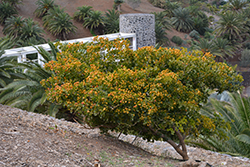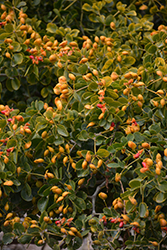It's all about ...
plants

Rough Bark Lignum Vitae
Guaiacum officinale
Height: 30 feet
Spread: 25 feet
Sunlight:
![]()
![]()
Hardiness Zone: 10a
Other Names: Guaiacwood, Pockholz, Wood Of Life, Guajacum
Description:
A slow growing, multi-stemmed, broadleaf evergreen tree or large shrub that is great for dry, coastal areas once established; blooms on and off throughout the year, but mostly in early spring; an excellent border or landscape accent
Ornamental Features
Rough Bark Lignum Vitae is bathed in stunning clusters of lavender star-shaped flowers with blue overtones at the ends of the branches from late winter to mid spring. The fruits are showy yellow pods with a orange blush, which are carried in abundance from early summer to late fall. The fruit can be messy if allowed to drop on the lawn or walkways, and may require occasional clean-up. It has dark green evergreen foliage. The glossy oval leaves remain dark green throughout the winter. The rough brown bark is extremely showy and adds significant winter interest.
Landscape Attributes
Rough Bark Lignum Vitae is a multi-stemmed evergreen tree with an upright spreading habit of growth. Its average texture blends into the landscape, but can be balanced by one or two finer or coarser trees or shrubs for an effective composition.
This tree will require occasional maintenance and upkeep, and should only be pruned after flowering to avoid removing any of the current season's flowers. It is a good choice for attracting bees and butterflies to your yard. It has no significant negative characteristics.
Rough Bark Lignum Vitae is recommended for the following landscape applications;
- Accent
- Shade
- Container Planting
Planting & Growing
Rough Bark Lignum Vitae will grow to be about 30 feet tall at maturity, with a spread of 25 feet. It has a low canopy with a typical clearance of 2 feet from the ground, and is suitable for planting under power lines. It grows at a slow rate, and under ideal conditions can be expected to live for 80 years or more.
This tree does best in full sun to partial shade. It prefers to grow in average to moist conditions, and shouldn't be allowed to dry out. This plant does not require much in the way of fertilizing once established. It is not particular as to soil type or pH, and is able to handle environmental salt. It is highly tolerant of urban pollution and will even thrive in inner city environments. This species is not originally from North America.
Rough Bark Lignum Vitae is a fine choice for the yard, but it is also a good selection for planting in outdoor pots and containers. Its large size and upright habit of growth lend it for use as a solitary accent, or in a composition surrounded by smaller plants around the base and those that spill over the edges. It is even sizeable enough that it can be grown alone in a suitable container. Note that when grown in a container, it may not perform exactly as indicated on the tag - this is to be expected. Also note that when growing plants in outdoor containers and baskets, they may require more frequent waterings than they would in the yard or garden. Be aware that in our climate, most plants cannot be expected to survive the winter if left in containers outdoors, and this plant is no exception. Contact our experts for more information on how to protect it over the winter months.
This plant is not reliably hardy in our region, and certain restrictions may apply; contact the store for more information.

